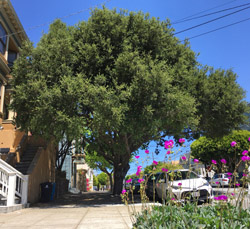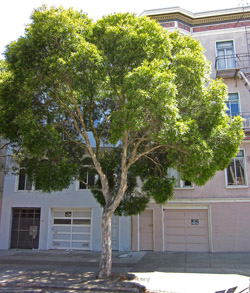
Quercus agrifolia — native to the area
Very few of the tree species we plant are native; they include Coast Live Oak (Quercus agrifolia) and California Buckeye (Aesculus californica). But few tree species are native to San Francisco, and their populations were small; the western land was mostly sand dunes and the rest was mostly shrubs, grasses, and rocks. Monterey Cypress (Cupressus macrocarpa), Monterey Pine (Pinus radiata), and California Bay Laurel (Umbellularia californica) also grew in the area, and — like our other native trees — can be found today in parks and private property (such as back yards).
But the requirements for street trees constrain our options — the trees must be able to thrive in small basins, must allow certain clearances for pedestrians and vehicles, and shouldn’t have a tendency to break the sidewalk. Native trees aren’t suitable for most sites that can accommodate a street tree in San Francisco.

Tristaniopsis laurina — from Australia
For those sites, if the choice is to plant non-native trees or no trees at all, we’ll plant non-natives, because they still perform vital services. The city itself is a non-native environment, populated by mostly non-native people, and can’t be sustained by native resources alone.
At least our non-native trees haven’t replaced native trees so much as they have replaced sand dunes!
In our Sidewalk Garden program we plant mostly native species, such as Hummingbird Sage (Salvia spathacea), Moonshine Yarrow (Achillea ‘Moonshine’), and Siskiyou Blue Fescue (Festuca ‘Siskiyou Blue’).